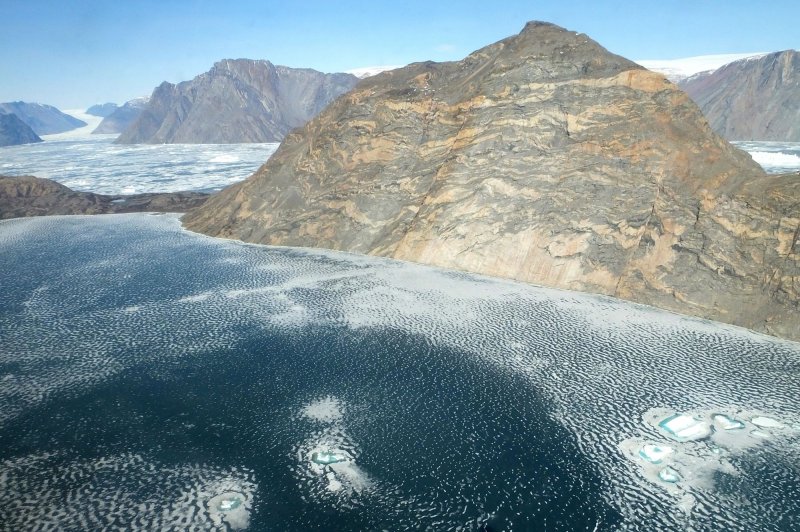1 of 6 | On May 19, 2016, NASA's IceBridge, an airborne survey of polar ice, crossed Greenland to fly central glacier flowlines in the east-central region of the country. This photo captures the fjord of Violin Glacier, with Nord Glacier at the upper left corner. This is IceBridge's eighth spring campaign of science flights over Arctic sea and land. NASA Photo by Maria Jose Vinas/UPI |
License Photo
WASHINGTON, Dec. 29 (UPI) -- It was a record year for ice. The theme was scarcity. There's less ice on Earth than there has been in some time. Ice sheets are shrinking, glaciers are melting, sea ice is receding.
If there is a silver lining, it is that humans are more aware of these trends than they were five or 10 years ago. In 2016, scientists continued to bolster technologies used to track and measure the movement of Earth's polar ice. Researchers improved models designed to tease out the intricate relationships between climate change, ice sheets, ocean currents, sea levels and a range of ecological systems.
The South Pole
In Antarctica, the focus has been on West Antarctica and the West Antarctic Ice Sheet. As a number of new studies showed, glaciers in West Antarctica continue to melt at an accelerating rate. Scientists believe warm ocean currents and rising air temperatures are weakening glaciers from the top and the bottom.
One study found evidence of inland rifting, which suggests the frailties of the West Antarctic Ice Sheet aren't isolated on the coast. Another found glaciers are shedding mass at record rates.
Observations by scientists with the British Antarctic Survey suggest glacial retreat in West Antarctica dates back to the 1940s. Satellite data showed glaciers have been thinning for several decades.
The North Pole
While scientists in the Southern Hemisphere tend to focus on glaciers, studies in the Arctic mostly focus on sea ice. Like glaciers in Antarctica, sea ice surrounding the North Pole is in retreat. The coverage of ice across the Arctic ebbs and flows with the seasons. Generally -- and logically -- there's more ice in the winter and less ice in the summer. This year, both the highs and lows were lower than ever before.
Seven of the 12 months in 2016 set new record lows for average sea ice extent. The most recent example: the average extent in November 2016 was smaller than all average November extents since 1981. The summer and winter extent either matched or set new record lows.
Want to know exactly how you're contributing to sea ice lows? One group of scientists calculated how individual carbon footprints contribute to sea ice melting.
Though glaciers in Antarctica are most relevant to sea level change, there are some glaciers in the Arctic -- in Greenland -- and they're melting, too. Together, the sea ice and glacier measurements collected in the Arctic suggest a "new normal" is settling into place. In other words, climate change in the Arctic and the consequential ecological shifts have accelerated past the point of no return -- at least for the foreseeable future.
Predicting the future
The consensus among scientists is that man-made carbon emissions have a sizable warming effect on Earth's atmosphere and climate. This larger reality -- the global carbon cycle and its climatological impacts -- consists of thousands of inputs and outputs, interrelated by specific cycles. Predicting how larger atmospheric carbon levels will affect Earth's many cycles and systems -- whether meteorological, oceanic, ecological -- is the focus of today's climate scientists.
One way to understand how carbon levels will influence future systems is studying how carbon influenced Earth's systems in the past. Records of Earth's ancient climate can be found in sediment and ice samples. Researchers recently set out to find Earth's oldest ice samples in Antarctica, continuing the effort to predict the future by understanding Earth's past.















